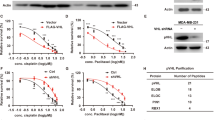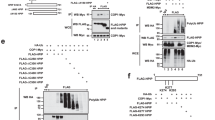Abstract
Endocrine therapies that inhibit estrogen receptor (ER)-α signaling are the most common and effective treatment for ER-α-positive breast cancer. However, the use of these agents is limited by the frequent development of resistance. The aim of this study was to elucidate the mechanisms by which downregulation of CDK10 expression confers resistance to tamoxifen in breast cancer. Here, we show that peptidyl-prolyl isomerase Pin1 downregulates CDK10 protein as a result of its interaction with and ubiquitination of CDK10, thereby affecting CDK10-dependent Raf-1 phosphorylation (S338). Pin1–/– mouse embryonic fibroblasts (MEFs) show higher CDK10 expression than Pin1+/+ MEFs, whereas CDK10 protein was downregulated in the rescued Pin1–/– MEFs after reexpression of Pin1. Pin1 silencing in SKBR-3 and MCF7 cells increased the CDK10 expression. In human tamoxifen-resistant breast cancer and tamoxifen-resistant MCF7 cells, immunohistochemical staining and immunoblotting analysis shows an inverse correlation between the expression of CDK10 and the degree of tamoxifen resistance. There was also a positive correlation between the high level of P-Raf-1 (Ser338) and Pin1 in human tamoxifen-resistant breast cancer and tamoxifen-resistant MCF7 (TAMR-MCF7) cells. Importantly, 4-OH tamoxifen (4-OHT), when used in combination with overexpressed CDK10 or Raf-1 inhibitor, increased cleaved PARP and DNA fragmentation to inhibit cologenic growth of MCF7 cells and Tamoxifen-resistant MCF7 cells, respectively. On the basis of these findings, we suggest that the Pin1-mediated CDK10 ubiquitination is a major regulator of tamoxifen-resistant breast cancer cell growth and survival.
This is a preview of subscription content, access via your institution
Access options
Subscribe to this journal
Receive 50 print issues and online access
$259.00 per year
only $5.18 per issue
Buy this article
- Purchase on Springer Link
- Instant access to full article PDF
Prices may be subject to local taxes which are calculated during checkout






Similar content being viewed by others
References
Ali S, Coombes RC . (2002). Endocrine-responsive breast cancer and strategies for combating resistance. Nat Rev Cancer 2: 101–112.
Brambilla R, Draetta G . (1994). Molecular cloning of PISSLRE, a novel putative member of the cdk family of protein serine/threonine kinases. Oncogene 9: 3037–3041.
Clarke R, Liu MC, Bouker KB, Gu Z, Lee RY, Zhu Y et al. (2003). Antiestrogen resistance in breast cancer and the role of estrogen receptor signaling. Oncogene 22: 7316–7339.
Deroo BJ, Korach KS . (2006). Estrogen receptors and human disease. J Clin Invest 116: 561–570.
Dougherty MK, Muller J, Ritt DA, Zhou M, Zhou XZ, Copeland TD et al. (2005). Regulation of Raf-1 by direct feedback phosphorylation. Mol Cell 17: 215–224.
EBCTCG (2005). Effects of chemotherapy and hormonal therapy for early breast cancer on recurrence and 15-year survival: an overview of the randomised trials. Lancet 365: 1687–1717.
El-Ashry D, Miller DL, Kharbanda S, Lippman ME, Kern FG . (1997). Constitutive Raf-1 kinase activity in breast cancer cells induces both estrogen-independent growth and apoptosis. Oncogene 15: 423–435.
Finn G, Lu KP . (2008). Phosphorylation-specific prolyl isomerase Pin1 as a new diagnostic and therapeutic target for cancer. Curr Cancer Drug Targets 8: 223–229.
Giacinti L, Claudio PP, Lopez M, Giordano A . (2006). Epigenetic information and estrogen receptor alpha expression in breast cancer. Oncologist 11: 1–8.
Heller G, Ziegler B, Brandstetter A, Novak S, Rudas M, Hennig G et al. (2009). CDK10 is not a target for aberrant DNA methylation in breast cancer. Anticancer Res 29: 3939–3944.
Iorns E, Turner NC, Elliott R, Syed N, Garrone O, Gasco M et al. (2008). Identification of CDK10 as an important determinant of resistance to endocrine therapy for breast cancer. Cancer Cell 13: 91–104.
Le Goff P, Montano MM, Schodin DJ, Katzenellenbogen BS . (1994). Phosphorylation of the human estrogen receptor. Identification of hormone-regulated sites and examination of their influence on transcriptional activity. J Biol Chem 269: 4458–4466.
Lee M, Koh WS, Han SS . (2003). Down-regulation of Raf-1 kinase is associated with paclitaxel resistance in human breast cancer MCF-7/Adr cells. Cancer Lett 193: 57–64.
Li S, MacLachlan TK, De Luca A, Claudio PP, Condorelli G, Giordano A . (1995). The cdc-2-related kinase, PISSLRE, is essential for cell growth and acts in G2 phase of the cell cycle. Cancer Res 55: 3992–3995.
Lu KP . (2003). Prolyl isomerase Pin1 as a molecular target for cancer diagnostics and therapeutics. Cancer Cell 4: 175–180.
Lu KP, Hanes SD, Hunter T . (1996). A human peptidyl-prolyl isomerase essential for regulation of mitosis. Nature 380: 544–547.
Lu KP, Liou YC, Zhou XZ . (2002). Pinning down proline-directed phosphorylation signaling. Trends Cell Biol 12: 164–172.
Massarweh S, Osborne CK, Creighton CJ, Qin L, Tsimelzon A, Huang S et al. (2008). Tamoxifen resistance in breast tumors is driven by growth factor receptor signaling with repression of classic estrogen receptor genomic function. Cancer Res 68: 826–833.
McGlynn LM, Kirkegaard T, Edwards J, Tovey S, Cameron D, Twelves C et al. (2009). Ras/Raf-1/MAPK pathway mediates response to tamoxifen but not chemotherapy in breast cancer patients. Clin Cancer Res 15: 1487–1495.
Morgan DO . (1997). Cyclin-dependent kinases: engines, clocks, and microprocessors. Annu Rev Cell Dev Biol 13: 261–291.
Namgoong GM, Khanal P, Cho HG, Lim SC, Oh YK, Kang BS et al. (2010). The prolyl isomerase Pin1 induces LC-3 expression and mediates tamoxifen resistance in breast cancer. J Biol Chem 285: 23829–23841.
Norbury C, Nurse P . (1992). Animal cell cycles and their control. Annu Rev Biochem 61: 441–470.
Oh AS, Lorant LA, Holloway JN, Miller DL, Kern FG, El-Ashry D . (2001). Hyperactivation of MAPK induces loss of ERalpha expression in breast cancer cells. Mol Endocrinol 15: 1344–1359.
Osborne CK, Shou J, Massarweh S, Schiff R . (2005). Crosstalk between estrogen receptor and growth factor receptor pathways as a cause for endocrine therapy resistance in breast cancer. Clin Cancer Res 11: 865s–870s.
Pietras RJ, Arboleda J, Reese DM, Wongvipat N, Pegram MD, Ramos L et al. (1995). HER-2 tyrosine kinase pathway targets estrogen receptor and promotes hormone-independent growth in human breast cancer cells. Oncogene 10: 2435–2446.
Riggs BL, Hartmann LC . (2003). Selective estrogen-receptor modulators -- mechanisms of action and application to clinical practice. N Engl J Med 348: 618–629.
Ryo A, Liou YC, Lu KP, Wulf G . (2003). Prolyl isomerase Pin1: a catalyst for oncogenesis and a potential therapeutic target in cancer. J Cell Sci 116: 773–783.
Shang Y, Brown M . (2002). Molecular determinants for the tissue specificity of SERMs. Science 295: 2465–2468.
Shou J, Massarweh S, Osborne CK, Wakeling AE, Ali S, Weiss H et al. (2004). Mechanisms of tamoxifen resistance: increased estrogen receptor-HER2/neu cross-talk in ER/HER2-positive breast cancer. J Natl Cancer Inst 96: 926–935.
Stanya KJ, Liu Y, Means AR, Kao HY . (2008). Cdk2 and Pin1 negatively regulate the transcriptional corepressor SMRT. J Cell Biol 183: 49–61.
Trowbridge JM, Rogatsky I, Garabedian MJ . (1997). Regulation of estrogen receptor transcriptional enhancement by the cyclin A/Cdk2 complex. Proc Natl Acad Sci USA 94: 10132–10137.
Valabrega G, Capellero S, Cavalloni G, Zaccarello G, Petrelli A, Migliardi G et al. (2011). HER2-positive breast cancer cells resistant to trastuzumab and lapatinib lose reliance upon HER2 and are sensitive to the multitargeted kinase inhibitor sorafenib. Breast Cancer Res Treat 130: 29–40.
Wilhelm SM, Carter C, Tang L, Wilkie D, McNabola A, Rong H et al. (2004). BAY 43-9006 exhibits broad spectrum oral antitumor activity and targets the RAF/MEK/ERK pathway and receptor tyrosine kinases involved in tumor progression and angiogenesis. Cancer Res 64: 7099–7109.
Wulf G, Finn G, Suizu F, Lu KP . (2005). Phosphorylation-specific prolyl isomerization: is there an underlying theme? Nat Cell Biol 7: 435–441.
Wulf GM, Ryo A, Wulf GG, Lee SW, Niu T, Petkova V et al. (2001). Pin1 is overexpressed in breast cancer and cooperates with Ras signaling in increasing the transcriptional activity of c-Jun towards cyclin D1. EMBO J 20: 3459–3472.
Yaffe MB, Schutkowski M, Shen M, Zhou XZ, Stukenberg PT, Rahfeld JU et al. (1997). Sequence-specific and phosphorylation-dependent proline isomerization: a potential mitotic regulatory mechanism. Science 278: 1957–1960.
Yi P, Wu RC, Sandquist J, Wong J, Tsai SY, Tsai MJ et al. (2005). Peptidyl-prolyl isomerase 1 (Pin1) serves as a coactivator of steroid receptor by regulating the activity of phosphorylated steroid receptor coactivator 3 (SRC-3/AIB1). Mol Cell Biol 25: 9687–9699.
Yoshiji H, Kuriyama S, Yoshii J, Ikenaka Y, Noguchi R, Hicklin DJ et al. (2004). Halting the interaction between vascular endothelial growth factor and its receptors attenuates liver carcinogenesis in mice. Hepatology 39: 1517–1524.
Zwijsen RM, Wientjens E, Klompmaker R, van der Sman J, Bernards R, Michalides RJ . (1997). CDK-independent activation of estrogen receptor by cyclin D1. Cell 88: 405–415.
Acknowledgements
This research was supported by the Basic Science Research Program through the National Research Foundation of Korea (NRF) funded by the Ministry of Education, Science, and Technology (2009-0073468 and 2010-0009728).
Author information
Authors and Affiliations
Corresponding author
Ethics declarations
Competing interests
The authors declare no conflict of interest.
Rights and permissions
About this article
Cite this article
Khanal, P., Yun, H., Lim, S. et al. Proyl isomerase Pin1 facilitates ubiquitin-mediated degradation of cyclin-dependent kinase 10 to induce tamoxifen resistance in breast cancer cells. Oncogene 31, 3845–3856 (2012). https://doi.org/10.1038/onc.2011.548
Received:
Revised:
Accepted:
Published:
Issue Date:
DOI: https://doi.org/10.1038/onc.2011.548
Keywords
This article is cited by
-
The PIN1-YTHDF1 axis promotes breast tumorigenesis via the m6A-dependent stabilization of AURKA mRNA
Archives of Pharmacal Research (2024)
-
The crosstalk between ubiquitination and endocrine therapy
Journal of Molecular Medicine (2023)
-
Identification of Prolyl isomerase Pin1 as a novel positive regulator of YAP/TAZ in breast cancer cells
Scientific Reports (2019)
-
Prolyl isomerase Pin1: a promoter of cancer and a target for therapy
Cell Death & Disease (2018)
-
PIN1 in breast development and cancer: a clinical perspective
Cell Death & Differentiation (2017)



